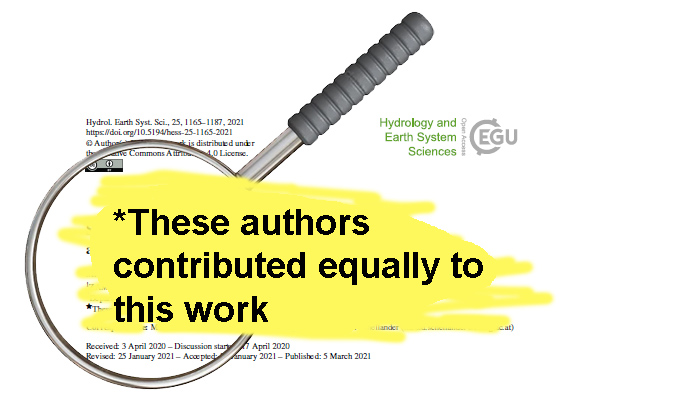
Have you heard of the option to have two first authors? Or seen the little star that indicates that both first authors have equally contributed to the work? I got to know the concept many years ago, without having ever used it. Now, one of my PhD students is working on a shared paper. My first reaction as a supervisor was: let’s have a quick look on the current rules about shared first authorship.
This was one of those quick searches that ended up in a long journey on the web. What I learnt from the Swiss Academy of Science in its report on Authorship in scientific publications, Analysis and recommendations: “In recent years, the practice of listing two people as joint first authors has become established; the fact that both authors equally contributed to the publication is indicated in a note.”
This report dates back to 2013!
As far as I remember, Springer Nature was one of the first editing houses that introduced that option – on their web site on authorship it is now stated: “Nature Portfolio journals also allow one set of co-authors to be specified as having contributed equally to the work”. Similar rules exist e.g. for Wiley (“joint first author”) and Elsevier (“joint first authorship“). In HESS, the equal contribution can be annotated with a star (see the example paper in the header image) if the corresponding information is included in the manuscript (see box at the end of the post).
What I learned from my long journey on the web is that:
- shared first authorship is commonly denoted with a star or similar on the front page;
- it is named “shared”, “joint”, “equal first authors” or even “co-first author”;
- it is hard to find specific examples of such papers because shared first authorship is not a search criterion;
- there are very few guidelines on how to deal with a shared first author paper in a CV.
About this last issue, one option is to put your name first in the CV, even if in the official publication your name appears second – you need to be aware, however, that there are still evaluators who are not used to shared first authorship. Another option is to simply add the star indicating shared first authorship in your publication list, at the end of the corresponding paper entry.
My recommended solution as evaluator is the one mentioned by David G. Jensen back in 2005 (!) in a commentary on science.org: “(..) include a separate section on the CV for “First Author Publications”. In that section, the shared first-author paper is very hard to miss.”
Finally, there is a small body of literature on the question of how librarians and data bases actually deal with the topic., e.g. the paper “Shared First Authorship” by Lapidow and Scudder, 2019, in the Journal of the Medical Library Association. This paper contains some interesting milestones in the current practice of denoting author contributions, mentioning that “(..) in 1999, Nature adopted a policy of transparency, publishing each author’s role in the research and article preparation”. But Lapidow and Scudde clearly state that “(..) despite the growing number of guidelines, there are no recommendations in place to guide a paper that has been written by coauthors who have made equal contributions to the publication.”
The discussion on this topic can even be expanded: da Silva, in their 2021 paper on “Multiple co-first authors, co-corresponding authors and co-supervisors: a synthesis of shared authorship credit”, mention three author status-related issues that are usually not discussed in guidelines, which are co-first authors, co-corresponding authors and co-supervisors (collectively referred to as equally credited authors).
To conclude, I would like to urge you, the readers, to let us know if you have any relevant material on shared first authorship to … share!
How to indicate shared first authorship in a Copernicus Journal? "Shared first authorship" is not an option that you can choose during the submission; the star indicating equal contribution is added to the affiliation if this information is provided in the manuscript. You can also ask to change the running author accordingly (e.g. "D. Smith, H. Miller, et al." instead of "D. Smith et al."). It is unclear when this option has been introduced but it has existed since the first time an author provided this information. Finally, you can always include relevant information in the mandatory author contribution section.

Bettina Schaefli
One point that I did not emphasize enough is that shared first authorship is not just a new publishing option – it reflects how knowledge is created. Teams of co-authors who practice co-writing generate a lot of momentum during the writing process or during the data collection and analysis process. Conceptual papers deeply benefit from being conceived as co-written papers from the inception stage. Co-written papers might thus have an added value that cannot be achieved by traditional papers. We might all want to make an effort to push this forward, e.g. by practicing it ourselves and by talking about it.
Bettina Schaefli
And a second comment on how equal contribution could be formulated: Besides the simple annotation of “both authors contributed equally”, we could give specific details in the author contribution section, such as e.g in this paper by Janker and Thieme, 2021, https://link.springer.com/article/10.1007/s11625-021-00958-3: “Both authors contributed equally to the conceptual and analytical chapters of the paper. While the theory section was mainly the responsibility of J. Janker and the case studies were part of S. Thieme’s research, the conceptual framework and the writing process were developed collaboratively.”
Alex Phell
thanks for sharing, When I was preparing my PhD, we did not use this path. But sometimes dual authorship would be appropriate.
Daniel
Thank you for the article.
Soon all authorship will be confirmed via blockchain.